Timboon Fine Ice Cream: Marketing Strategy & Growth in Australia
VerifiedAdded on 2023/05/31
|17
|4891
|298
Report
AI Summary
This marketing strategy report builds upon a previous analysis of Timboon Fine Ice Cream, an Australian company, and focuses on growth strategies to increase sales. It utilizes the Ansoff Matrix, recommending a market development strategy to expand throughout Australia and New Zealand. The report details the target market, positioning strategy, and a marketing mix including product, pricing, distribution, and promotion. It also includes an extended marketing mix, covering people, physical evidence, and processes. The report suggests the company should also consider supplying waffles to increase sales. The overall aim is to help Timboon Fine Ice Cream achieve a competitive edge and sustain its market position by expanding its reach and offering relevant products.

RUNNING HEAD: Marketing
Marketing
[Type the document subtitle]
Laptop04011
[Pick the date]
Marketing
[Type the document subtitle]
Laptop04011
[Pick the date]
Paraphrase This Document
Need a fresh take? Get an instant paraphrase of this document with our AI Paraphraser
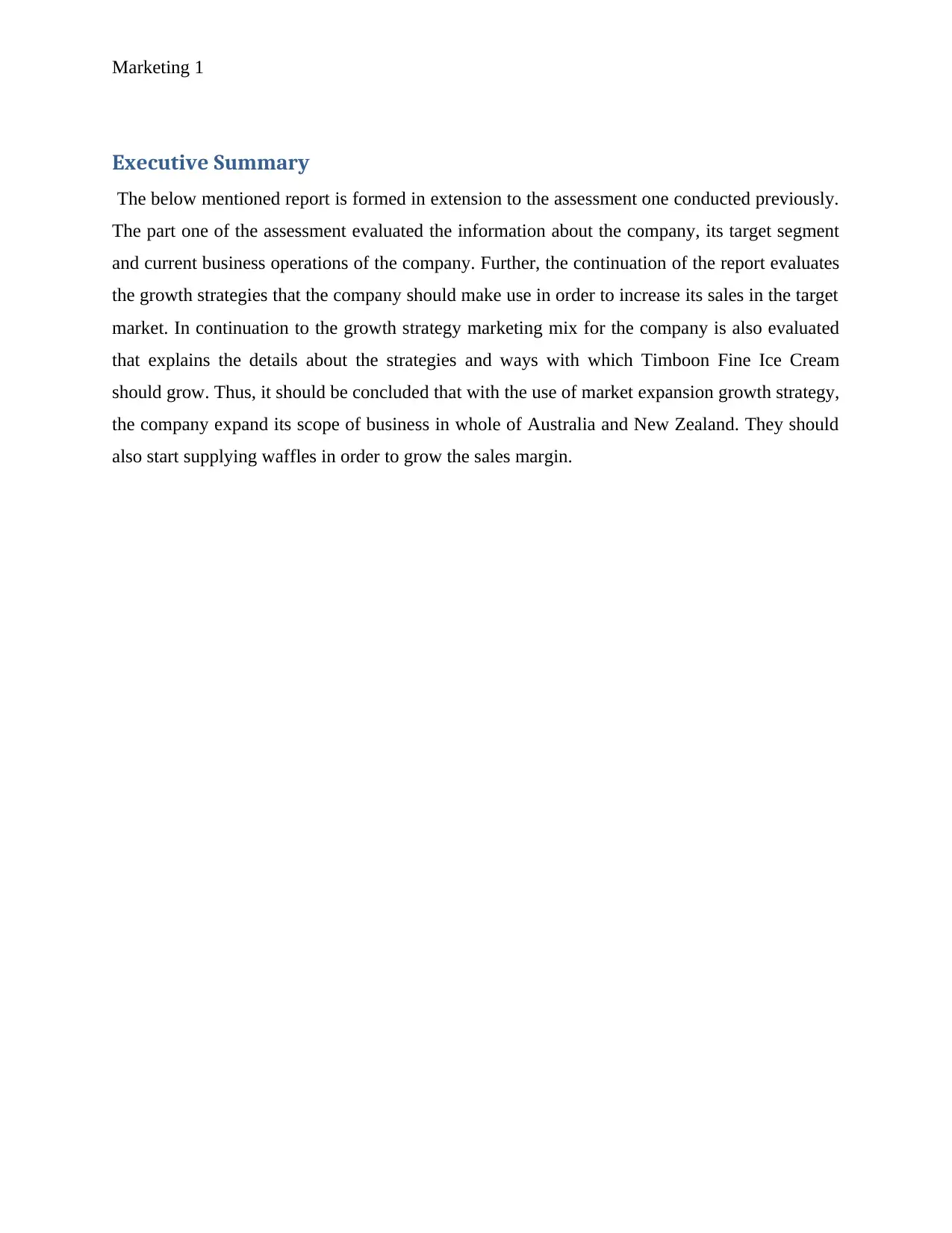
Marketing 1
Executive Summary
The below mentioned report is formed in extension to the assessment one conducted previously.
The part one of the assessment evaluated the information about the company, its target segment
and current business operations of the company. Further, the continuation of the report evaluates
the growth strategies that the company should make use in order to increase its sales in the target
market. In continuation to the growth strategy marketing mix for the company is also evaluated
that explains the details about the strategies and ways with which Timboon Fine Ice Cream
should grow. Thus, it should be concluded that with the use of market expansion growth strategy,
the company expand its scope of business in whole of Australia and New Zealand. They should
also start supplying waffles in order to grow the sales margin.
Executive Summary
The below mentioned report is formed in extension to the assessment one conducted previously.
The part one of the assessment evaluated the information about the company, its target segment
and current business operations of the company. Further, the continuation of the report evaluates
the growth strategies that the company should make use in order to increase its sales in the target
market. In continuation to the growth strategy marketing mix for the company is also evaluated
that explains the details about the strategies and ways with which Timboon Fine Ice Cream
should grow. Thus, it should be concluded that with the use of market expansion growth strategy,
the company expand its scope of business in whole of Australia and New Zealand. They should
also start supplying waffles in order to grow the sales margin.
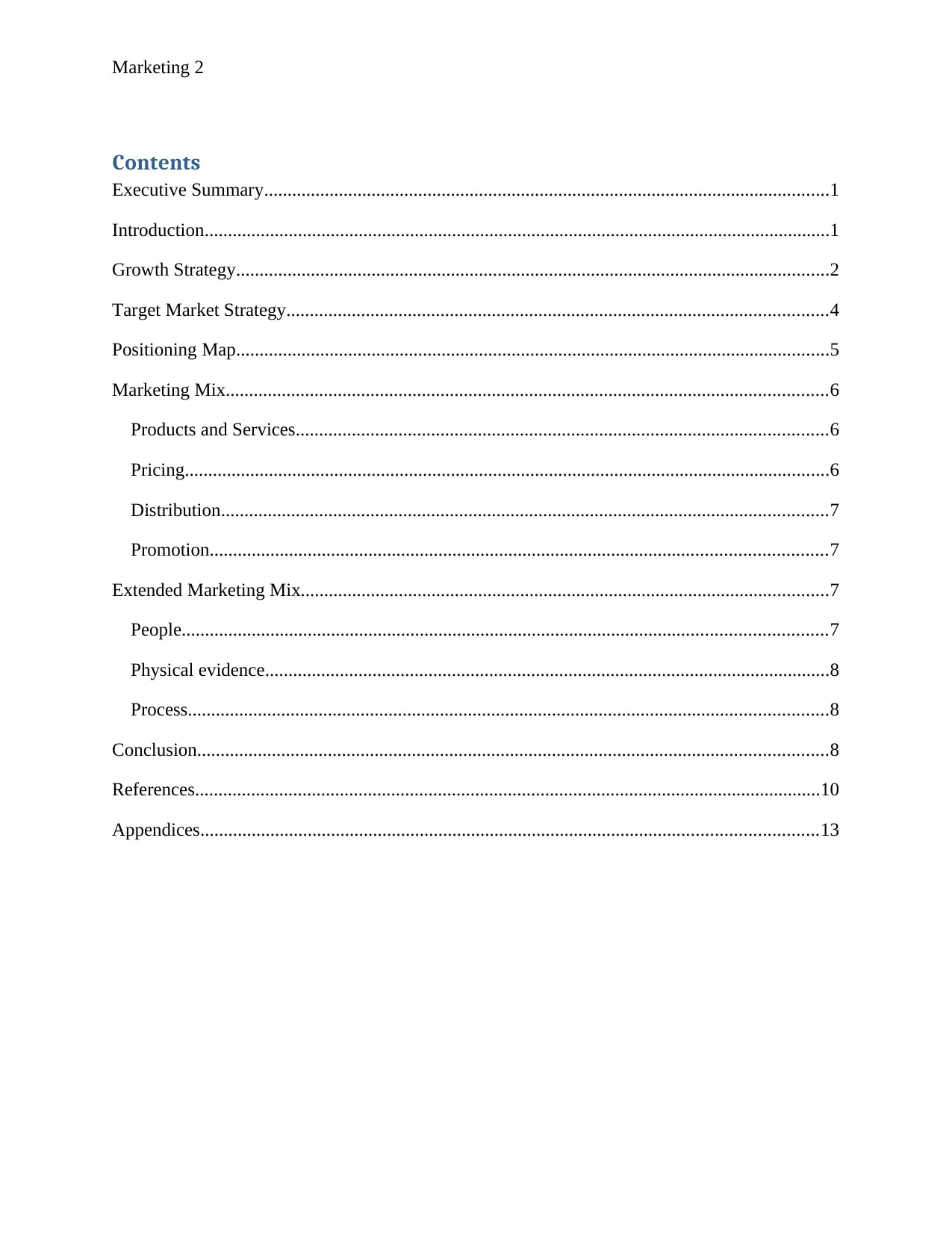
Marketing 2
Contents
Executive Summary.........................................................................................................................1
Introduction......................................................................................................................................1
Growth Strategy...............................................................................................................................2
Target Market Strategy....................................................................................................................4
Positioning Map...............................................................................................................................5
Marketing Mix.................................................................................................................................6
Products and Services..................................................................................................................6
Pricing..........................................................................................................................................6
Distribution..................................................................................................................................7
Promotion....................................................................................................................................7
Extended Marketing Mix.................................................................................................................7
People..........................................................................................................................................7
Physical evidence.........................................................................................................................8
Process.........................................................................................................................................8
Conclusion.......................................................................................................................................8
References......................................................................................................................................10
Appendices....................................................................................................................................13
Contents
Executive Summary.........................................................................................................................1
Introduction......................................................................................................................................1
Growth Strategy...............................................................................................................................2
Target Market Strategy....................................................................................................................4
Positioning Map...............................................................................................................................5
Marketing Mix.................................................................................................................................6
Products and Services..................................................................................................................6
Pricing..........................................................................................................................................6
Distribution..................................................................................................................................7
Promotion....................................................................................................................................7
Extended Marketing Mix.................................................................................................................7
People..........................................................................................................................................7
Physical evidence.........................................................................................................................8
Process.........................................................................................................................................8
Conclusion.......................................................................................................................................8
References......................................................................................................................................10
Appendices....................................................................................................................................13
⊘ This is a preview!⊘
Do you want full access?
Subscribe today to unlock all pages.

Trusted by 1+ million students worldwide
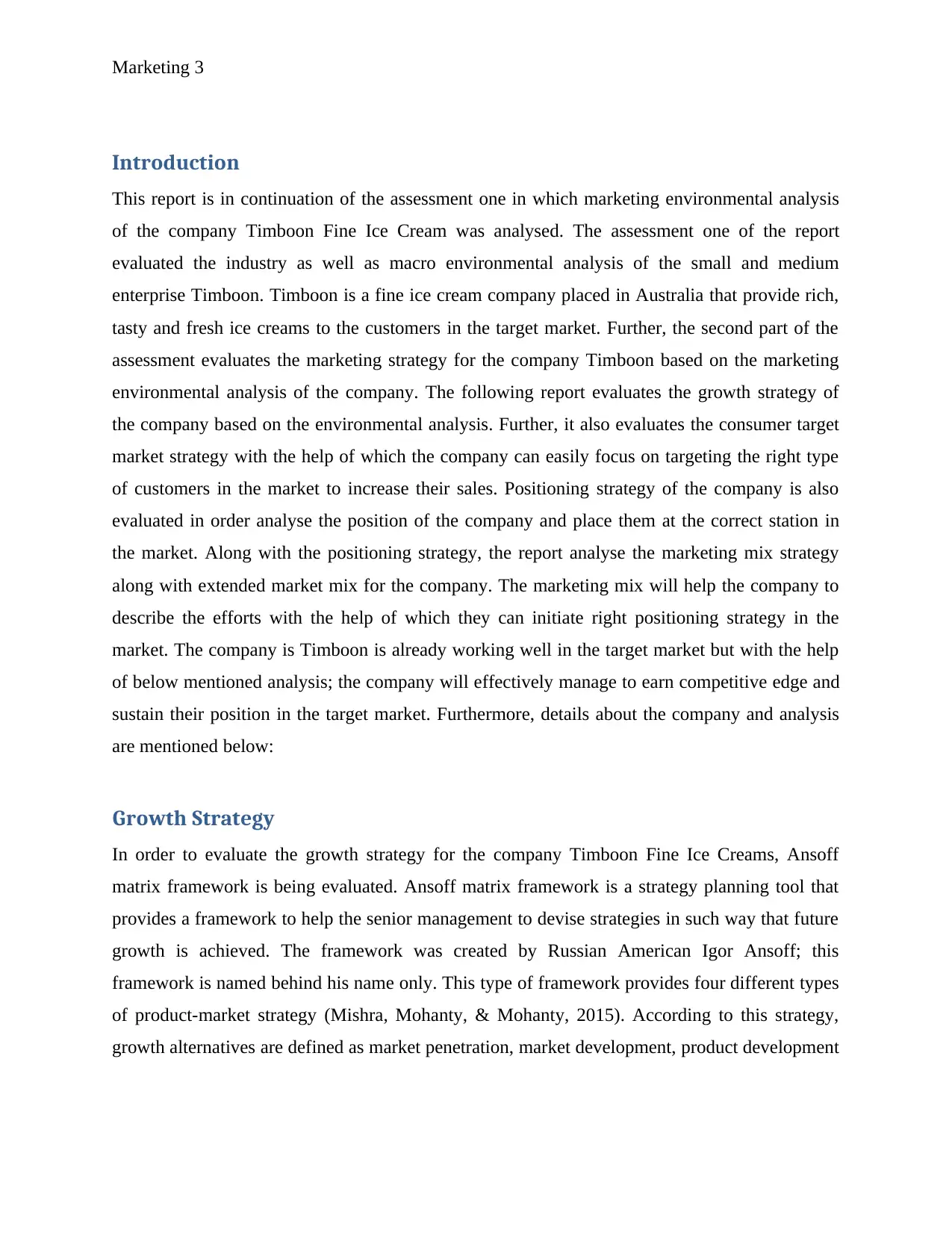
Marketing 3
Introduction
This report is in continuation of the assessment one in which marketing environmental analysis
of the company Timboon Fine Ice Cream was analysed. The assessment one of the report
evaluated the industry as well as macro environmental analysis of the small and medium
enterprise Timboon. Timboon is a fine ice cream company placed in Australia that provide rich,
tasty and fresh ice creams to the customers in the target market. Further, the second part of the
assessment evaluates the marketing strategy for the company Timboon based on the marketing
environmental analysis of the company. The following report evaluates the growth strategy of
the company based on the environmental analysis. Further, it also evaluates the consumer target
market strategy with the help of which the company can easily focus on targeting the right type
of customers in the market to increase their sales. Positioning strategy of the company is also
evaluated in order analyse the position of the company and place them at the correct station in
the market. Along with the positioning strategy, the report analyse the marketing mix strategy
along with extended market mix for the company. The marketing mix will help the company to
describe the efforts with the help of which they can initiate right positioning strategy in the
market. The company is Timboon is already working well in the target market but with the help
of below mentioned analysis; the company will effectively manage to earn competitive edge and
sustain their position in the target market. Furthermore, details about the company and analysis
are mentioned below:
Growth Strategy
In order to evaluate the growth strategy for the company Timboon Fine Ice Creams, Ansoff
matrix framework is being evaluated. Ansoff matrix framework is a strategy planning tool that
provides a framework to help the senior management to devise strategies in such way that future
growth is achieved. The framework was created by Russian American Igor Ansoff; this
framework is named behind his name only. This type of framework provides four different types
of product-market strategy (Mishra, Mohanty, & Mohanty, 2015). According to this strategy,
growth alternatives are defined as market penetration, market development, product development
Introduction
This report is in continuation of the assessment one in which marketing environmental analysis
of the company Timboon Fine Ice Cream was analysed. The assessment one of the report
evaluated the industry as well as macro environmental analysis of the small and medium
enterprise Timboon. Timboon is a fine ice cream company placed in Australia that provide rich,
tasty and fresh ice creams to the customers in the target market. Further, the second part of the
assessment evaluates the marketing strategy for the company Timboon based on the marketing
environmental analysis of the company. The following report evaluates the growth strategy of
the company based on the environmental analysis. Further, it also evaluates the consumer target
market strategy with the help of which the company can easily focus on targeting the right type
of customers in the market to increase their sales. Positioning strategy of the company is also
evaluated in order analyse the position of the company and place them at the correct station in
the market. Along with the positioning strategy, the report analyse the marketing mix strategy
along with extended market mix for the company. The marketing mix will help the company to
describe the efforts with the help of which they can initiate right positioning strategy in the
market. The company is Timboon is already working well in the target market but with the help
of below mentioned analysis; the company will effectively manage to earn competitive edge and
sustain their position in the target market. Furthermore, details about the company and analysis
are mentioned below:
Growth Strategy
In order to evaluate the growth strategy for the company Timboon Fine Ice Creams, Ansoff
matrix framework is being evaluated. Ansoff matrix framework is a strategy planning tool that
provides a framework to help the senior management to devise strategies in such way that future
growth is achieved. The framework was created by Russian American Igor Ansoff; this
framework is named behind his name only. This type of framework provides four different types
of product-market strategy (Mishra, Mohanty, & Mohanty, 2015). According to this strategy,
growth alternatives are defined as market penetration, market development, product development
Paraphrase This Document
Need a fresh take? Get an instant paraphrase of this document with our AI Paraphraser
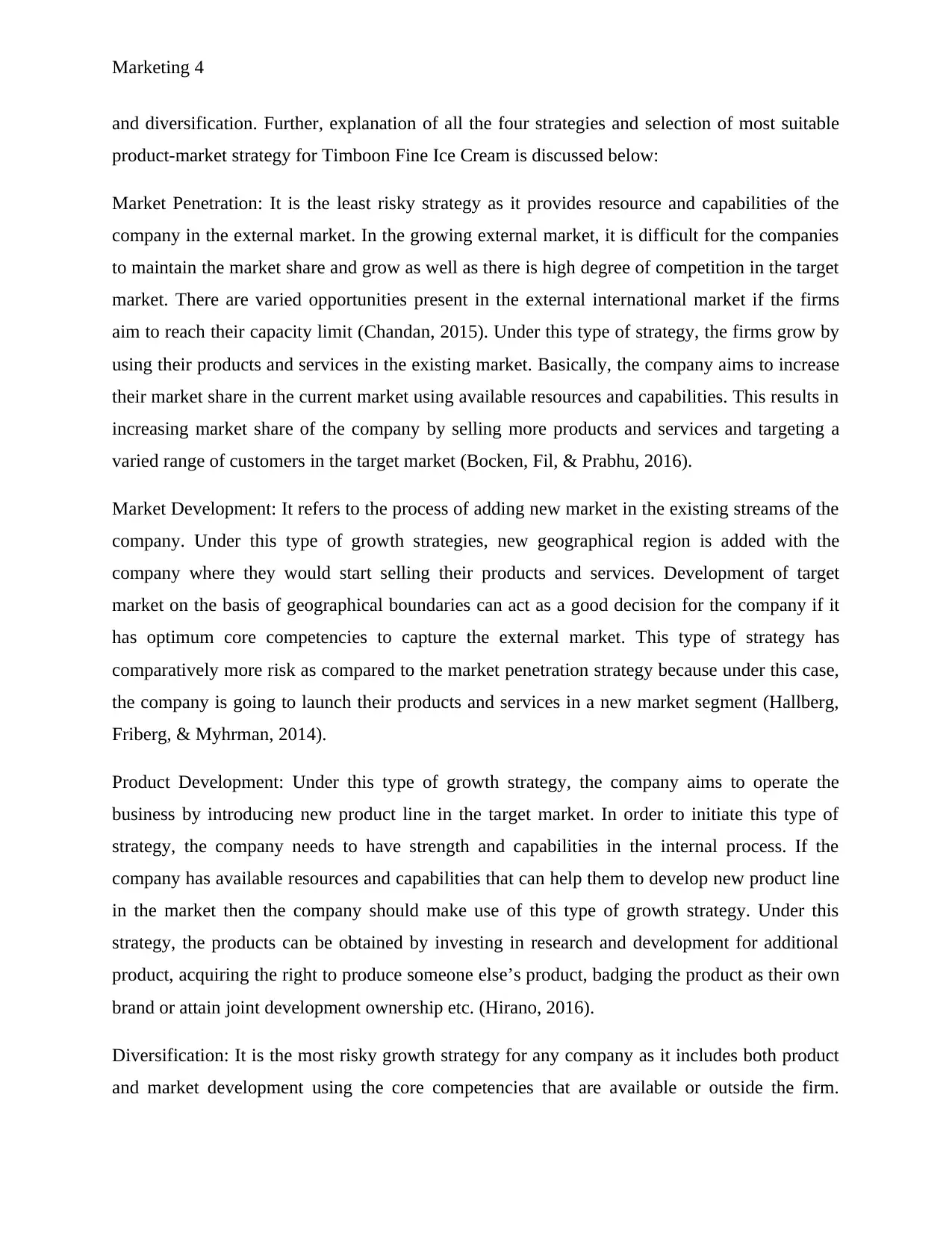
Marketing 4
and diversification. Further, explanation of all the four strategies and selection of most suitable
product-market strategy for Timboon Fine Ice Cream is discussed below:
Market Penetration: It is the least risky strategy as it provides resource and capabilities of the
company in the external market. In the growing external market, it is difficult for the companies
to maintain the market share and grow as well as there is high degree of competition in the target
market. There are varied opportunities present in the external international market if the firms
aim to reach their capacity limit (Chandan, 2015). Under this type of strategy, the firms grow by
using their products and services in the existing market. Basically, the company aims to increase
their market share in the current market using available resources and capabilities. This results in
increasing market share of the company by selling more products and services and targeting a
varied range of customers in the target market (Bocken, Fil, & Prabhu, 2016).
Market Development: It refers to the process of adding new market in the existing streams of the
company. Under this type of growth strategies, new geographical region is added with the
company where they would start selling their products and services. Development of target
market on the basis of geographical boundaries can act as a good decision for the company if it
has optimum core competencies to capture the external market. This type of strategy has
comparatively more risk as compared to the market penetration strategy because under this case,
the company is going to launch their products and services in a new market segment (Hallberg,
Friberg, & Myhrman, 2014).
Product Development: Under this type of growth strategy, the company aims to operate the
business by introducing new product line in the target market. In order to initiate this type of
strategy, the company needs to have strength and capabilities in the internal process. If the
company has available resources and capabilities that can help them to develop new product line
in the market then the company should make use of this type of growth strategy. Under this
strategy, the products can be obtained by investing in research and development for additional
product, acquiring the right to produce someone else’s product, badging the product as their own
brand or attain joint development ownership etc. (Hirano, 2016).
Diversification: It is the most risky growth strategy for any company as it includes both product
and market development using the core competencies that are available or outside the firm.
and diversification. Further, explanation of all the four strategies and selection of most suitable
product-market strategy for Timboon Fine Ice Cream is discussed below:
Market Penetration: It is the least risky strategy as it provides resource and capabilities of the
company in the external market. In the growing external market, it is difficult for the companies
to maintain the market share and grow as well as there is high degree of competition in the target
market. There are varied opportunities present in the external international market if the firms
aim to reach their capacity limit (Chandan, 2015). Under this type of strategy, the firms grow by
using their products and services in the existing market. Basically, the company aims to increase
their market share in the current market using available resources and capabilities. This results in
increasing market share of the company by selling more products and services and targeting a
varied range of customers in the target market (Bocken, Fil, & Prabhu, 2016).
Market Development: It refers to the process of adding new market in the existing streams of the
company. Under this type of growth strategies, new geographical region is added with the
company where they would start selling their products and services. Development of target
market on the basis of geographical boundaries can act as a good decision for the company if it
has optimum core competencies to capture the external market. This type of strategy has
comparatively more risk as compared to the market penetration strategy because under this case,
the company is going to launch their products and services in a new market segment (Hallberg,
Friberg, & Myhrman, 2014).
Product Development: Under this type of growth strategy, the company aims to operate the
business by introducing new product line in the target market. In order to initiate this type of
strategy, the company needs to have strength and capabilities in the internal process. If the
company has available resources and capabilities that can help them to develop new product line
in the market then the company should make use of this type of growth strategy. Under this
strategy, the products can be obtained by investing in research and development for additional
product, acquiring the right to produce someone else’s product, badging the product as their own
brand or attain joint development ownership etc. (Hirano, 2016).
Diversification: It is the most risky growth strategy for any company as it includes both product
and market development using the core competencies that are available or outside the firm.
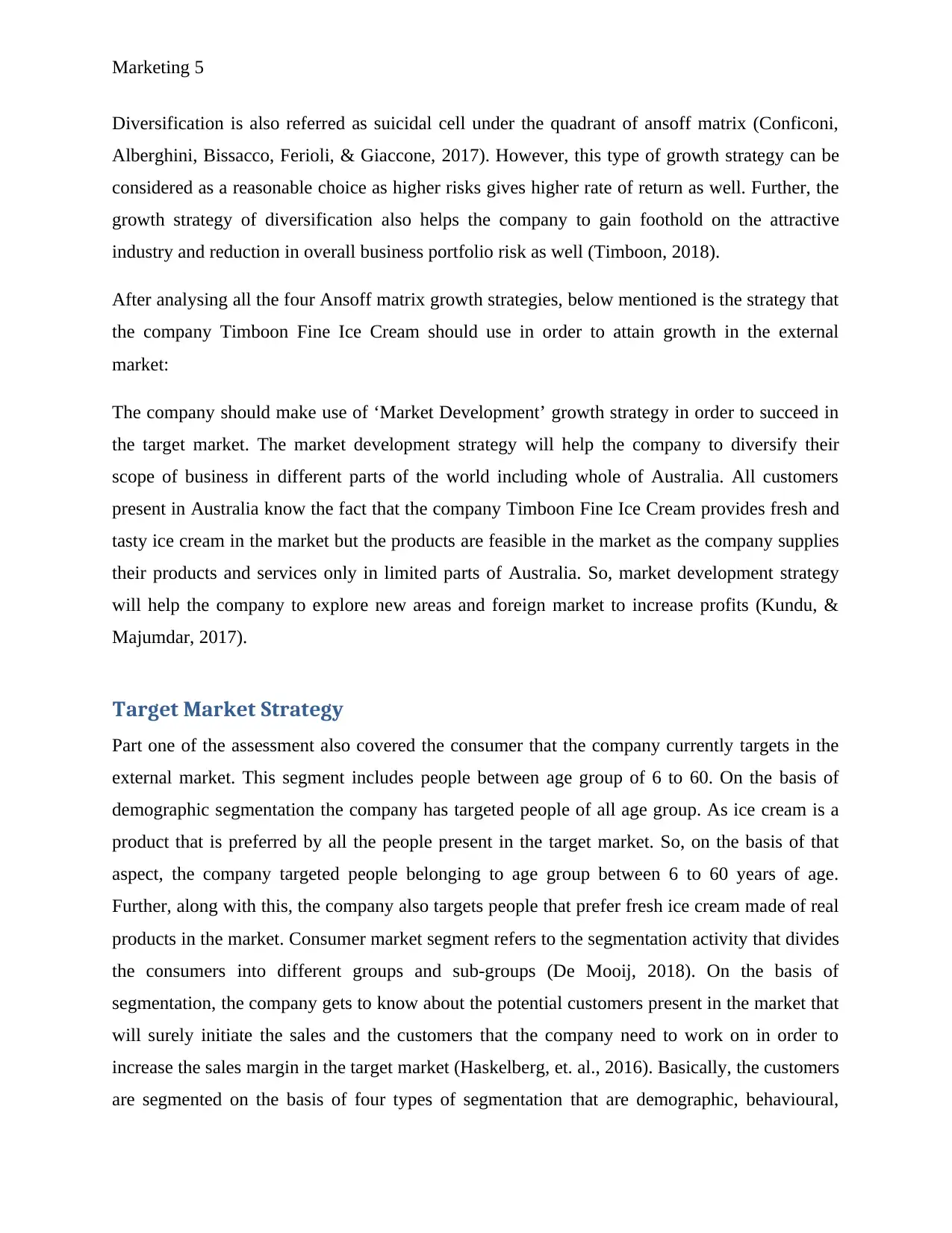
Marketing 5
Diversification is also referred as suicidal cell under the quadrant of ansoff matrix (Conficoni,
Alberghini, Bissacco, Ferioli, & Giaccone, 2017). However, this type of growth strategy can be
considered as a reasonable choice as higher risks gives higher rate of return as well. Further, the
growth strategy of diversification also helps the company to gain foothold on the attractive
industry and reduction in overall business portfolio risk as well (Timboon, 2018).
After analysing all the four Ansoff matrix growth strategies, below mentioned is the strategy that
the company Timboon Fine Ice Cream should use in order to attain growth in the external
market:
The company should make use of ‘Market Development’ growth strategy in order to succeed in
the target market. The market development strategy will help the company to diversify their
scope of business in different parts of the world including whole of Australia. All customers
present in Australia know the fact that the company Timboon Fine Ice Cream provides fresh and
tasty ice cream in the market but the products are feasible in the market as the company supplies
their products and services only in limited parts of Australia. So, market development strategy
will help the company to explore new areas and foreign market to increase profits (Kundu, &
Majumdar, 2017).
Target Market Strategy
Part one of the assessment also covered the consumer that the company currently targets in the
external market. This segment includes people between age group of 6 to 60. On the basis of
demographic segmentation the company has targeted people of all age group. As ice cream is a
product that is preferred by all the people present in the target market. So, on the basis of that
aspect, the company targeted people belonging to age group between 6 to 60 years of age.
Further, along with this, the company also targets people that prefer fresh ice cream made of real
products in the market. Consumer market segment refers to the segmentation activity that divides
the consumers into different groups and sub-groups (De Mooij, 2018). On the basis of
segmentation, the company gets to know about the potential customers present in the market that
will surely initiate the sales and the customers that the company need to work on in order to
increase the sales margin in the target market (Haskelberg, et. al., 2016). Basically, the customers
are segmented on the basis of four types of segmentation that are demographic, behavioural,
Diversification is also referred as suicidal cell under the quadrant of ansoff matrix (Conficoni,
Alberghini, Bissacco, Ferioli, & Giaccone, 2017). However, this type of growth strategy can be
considered as a reasonable choice as higher risks gives higher rate of return as well. Further, the
growth strategy of diversification also helps the company to gain foothold on the attractive
industry and reduction in overall business portfolio risk as well (Timboon, 2018).
After analysing all the four Ansoff matrix growth strategies, below mentioned is the strategy that
the company Timboon Fine Ice Cream should use in order to attain growth in the external
market:
The company should make use of ‘Market Development’ growth strategy in order to succeed in
the target market. The market development strategy will help the company to diversify their
scope of business in different parts of the world including whole of Australia. All customers
present in Australia know the fact that the company Timboon Fine Ice Cream provides fresh and
tasty ice cream in the market but the products are feasible in the market as the company supplies
their products and services only in limited parts of Australia. So, market development strategy
will help the company to explore new areas and foreign market to increase profits (Kundu, &
Majumdar, 2017).
Target Market Strategy
Part one of the assessment also covered the consumer that the company currently targets in the
external market. This segment includes people between age group of 6 to 60. On the basis of
demographic segmentation the company has targeted people of all age group. As ice cream is a
product that is preferred by all the people present in the target market. So, on the basis of that
aspect, the company targeted people belonging to age group between 6 to 60 years of age.
Further, along with this, the company also targets people that prefer fresh ice cream made of real
products in the market. Consumer market segment refers to the segmentation activity that divides
the consumers into different groups and sub-groups (De Mooij, 2018). On the basis of
segmentation, the company gets to know about the potential customers present in the market that
will surely initiate the sales and the customers that the company need to work on in order to
increase the sales margin in the target market (Haskelberg, et. al., 2016). Basically, the customers
are segmented on the basis of four types of segmentation that are demographic, behavioural,
⊘ This is a preview!⊘
Do you want full access?
Subscribe today to unlock all pages.

Trusted by 1+ million students worldwide
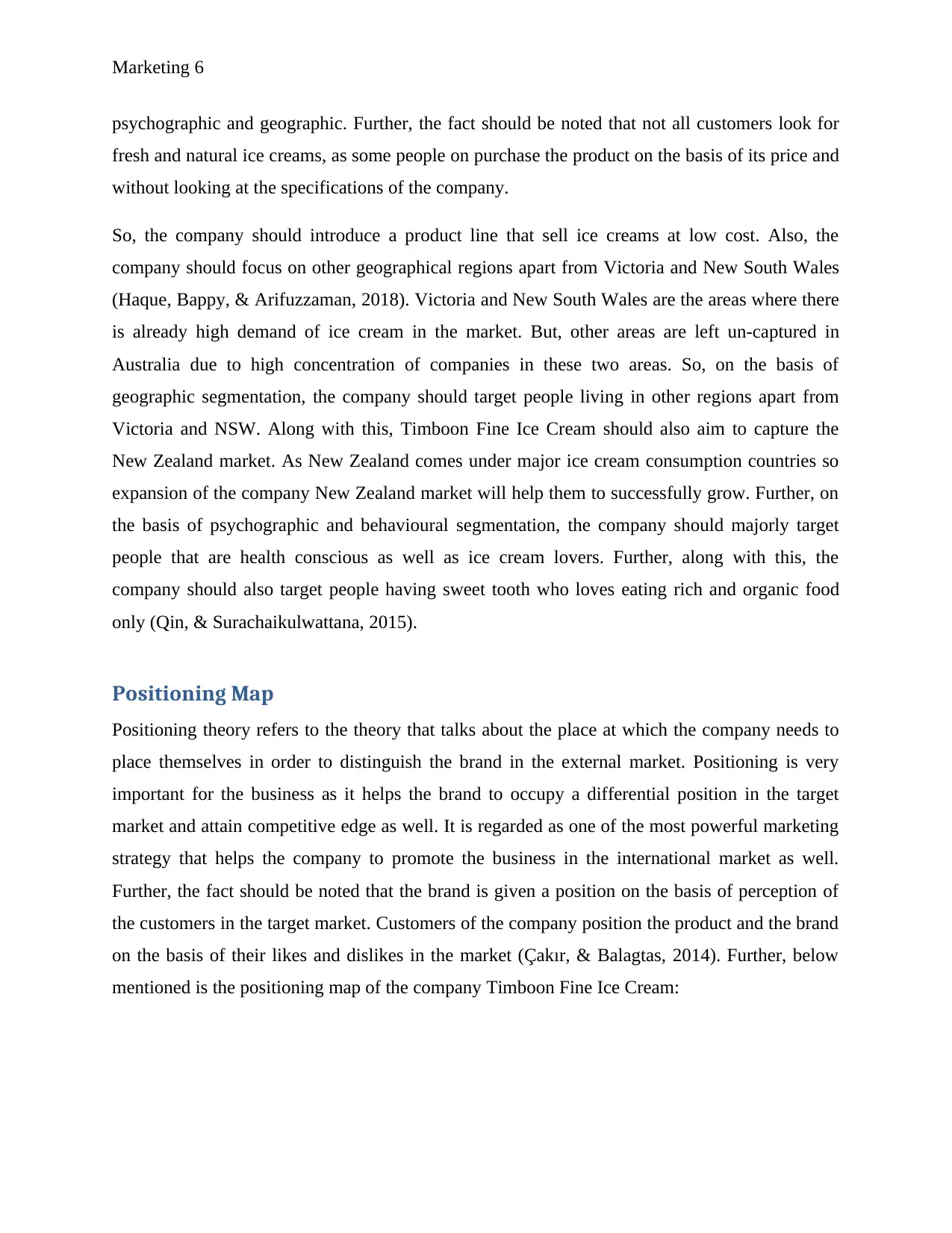
Marketing 6
psychographic and geographic. Further, the fact should be noted that not all customers look for
fresh and natural ice creams, as some people on purchase the product on the basis of its price and
without looking at the specifications of the company.
So, the company should introduce a product line that sell ice creams at low cost. Also, the
company should focus on other geographical regions apart from Victoria and New South Wales
(Haque, Bappy, & Arifuzzaman, 2018). Victoria and New South Wales are the areas where there
is already high demand of ice cream in the market. But, other areas are left un-captured in
Australia due to high concentration of companies in these two areas. So, on the basis of
geographic segmentation, the company should target people living in other regions apart from
Victoria and NSW. Along with this, Timboon Fine Ice Cream should also aim to capture the
New Zealand market. As New Zealand comes under major ice cream consumption countries so
expansion of the company New Zealand market will help them to successfully grow. Further, on
the basis of psychographic and behavioural segmentation, the company should majorly target
people that are health conscious as well as ice cream lovers. Further, along with this, the
company should also target people having sweet tooth who loves eating rich and organic food
only (Qin, & Surachaikulwattana, 2015).
Positioning Map
Positioning theory refers to the theory that talks about the place at which the company needs to
place themselves in order to distinguish the brand in the external market. Positioning is very
important for the business as it helps the brand to occupy a differential position in the target
market and attain competitive edge as well. It is regarded as one of the most powerful marketing
strategy that helps the company to promote the business in the international market as well.
Further, the fact should be noted that the brand is given a position on the basis of perception of
the customers in the target market. Customers of the company position the product and the brand
on the basis of their likes and dislikes in the market (Çakır, & Balagtas, 2014). Further, below
mentioned is the positioning map of the company Timboon Fine Ice Cream:
psychographic and geographic. Further, the fact should be noted that not all customers look for
fresh and natural ice creams, as some people on purchase the product on the basis of its price and
without looking at the specifications of the company.
So, the company should introduce a product line that sell ice creams at low cost. Also, the
company should focus on other geographical regions apart from Victoria and New South Wales
(Haque, Bappy, & Arifuzzaman, 2018). Victoria and New South Wales are the areas where there
is already high demand of ice cream in the market. But, other areas are left un-captured in
Australia due to high concentration of companies in these two areas. So, on the basis of
geographic segmentation, the company should target people living in other regions apart from
Victoria and NSW. Along with this, Timboon Fine Ice Cream should also aim to capture the
New Zealand market. As New Zealand comes under major ice cream consumption countries so
expansion of the company New Zealand market will help them to successfully grow. Further, on
the basis of psychographic and behavioural segmentation, the company should majorly target
people that are health conscious as well as ice cream lovers. Further, along with this, the
company should also target people having sweet tooth who loves eating rich and organic food
only (Qin, & Surachaikulwattana, 2015).
Positioning Map
Positioning theory refers to the theory that talks about the place at which the company needs to
place themselves in order to distinguish the brand in the external market. Positioning is very
important for the business as it helps the brand to occupy a differential position in the target
market and attain competitive edge as well. It is regarded as one of the most powerful marketing
strategy that helps the company to promote the business in the international market as well.
Further, the fact should be noted that the brand is given a position on the basis of perception of
the customers in the target market. Customers of the company position the product and the brand
on the basis of their likes and dislikes in the market (Çakır, & Balagtas, 2014). Further, below
mentioned is the positioning map of the company Timboon Fine Ice Cream:
Paraphrase This Document
Need a fresh take? Get an instant paraphrase of this document with our AI Paraphraser
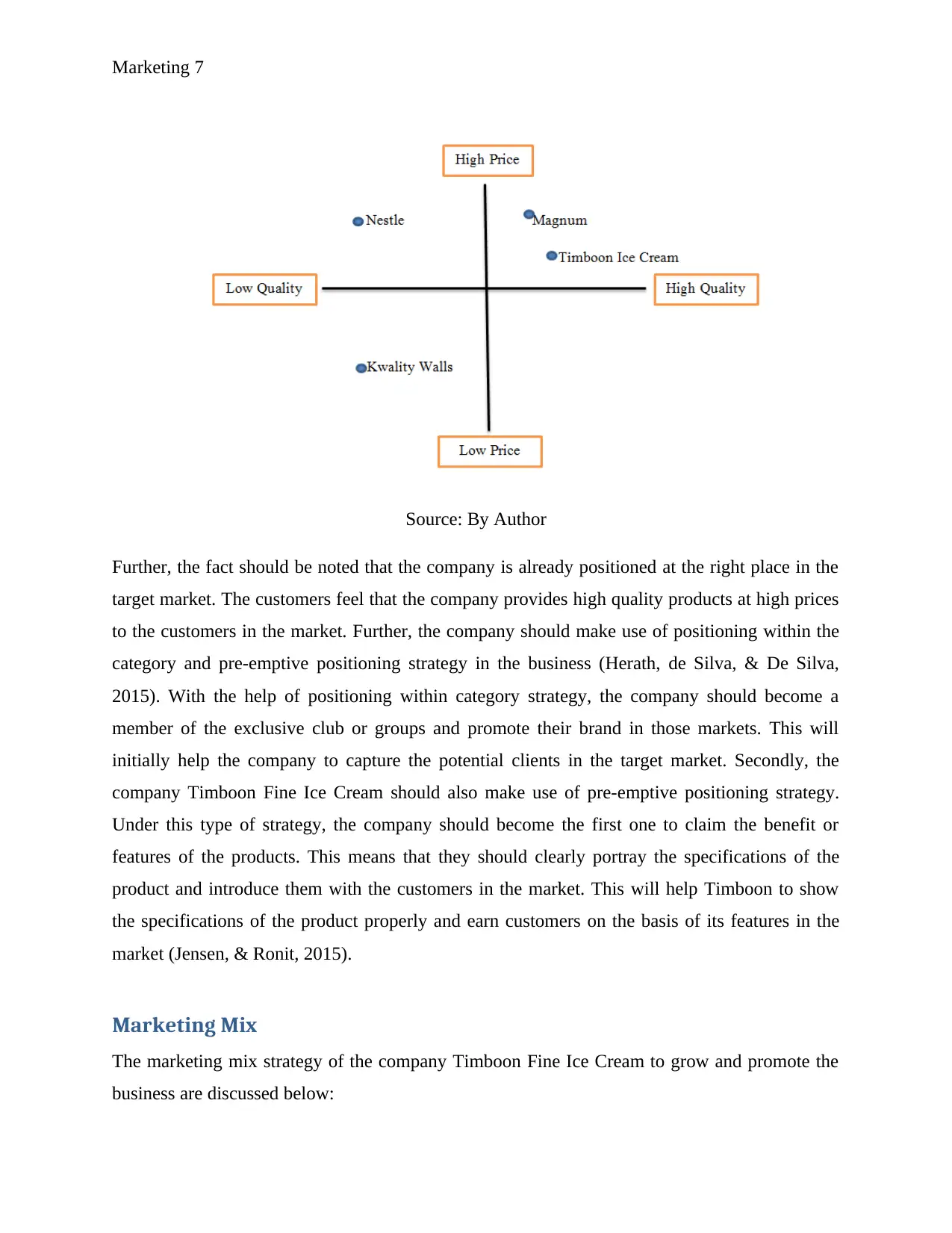
Marketing 7
Source: By Author
Further, the fact should be noted that the company is already positioned at the right place in the
target market. The customers feel that the company provides high quality products at high prices
to the customers in the market. Further, the company should make use of positioning within the
category and pre-emptive positioning strategy in the business (Herath, de Silva, & De Silva,
2015). With the help of positioning within category strategy, the company should become a
member of the exclusive club or groups and promote their brand in those markets. This will
initially help the company to capture the potential clients in the target market. Secondly, the
company Timboon Fine Ice Cream should also make use of pre-emptive positioning strategy.
Under this type of strategy, the company should become the first one to claim the benefit or
features of the products. This means that they should clearly portray the specifications of the
product and introduce them with the customers in the market. This will help Timboon to show
the specifications of the product properly and earn customers on the basis of its features in the
market (Jensen, & Ronit, 2015).
Marketing Mix
The marketing mix strategy of the company Timboon Fine Ice Cream to grow and promote the
business are discussed below:
Source: By Author
Further, the fact should be noted that the company is already positioned at the right place in the
target market. The customers feel that the company provides high quality products at high prices
to the customers in the market. Further, the company should make use of positioning within the
category and pre-emptive positioning strategy in the business (Herath, de Silva, & De Silva,
2015). With the help of positioning within category strategy, the company should become a
member of the exclusive club or groups and promote their brand in those markets. This will
initially help the company to capture the potential clients in the target market. Secondly, the
company Timboon Fine Ice Cream should also make use of pre-emptive positioning strategy.
Under this type of strategy, the company should become the first one to claim the benefit or
features of the products. This means that they should clearly portray the specifications of the
product and introduce them with the customers in the market. This will help Timboon to show
the specifications of the product properly and earn customers on the basis of its features in the
market (Jensen, & Ronit, 2015).
Marketing Mix
The marketing mix strategy of the company Timboon Fine Ice Cream to grow and promote the
business are discussed below:
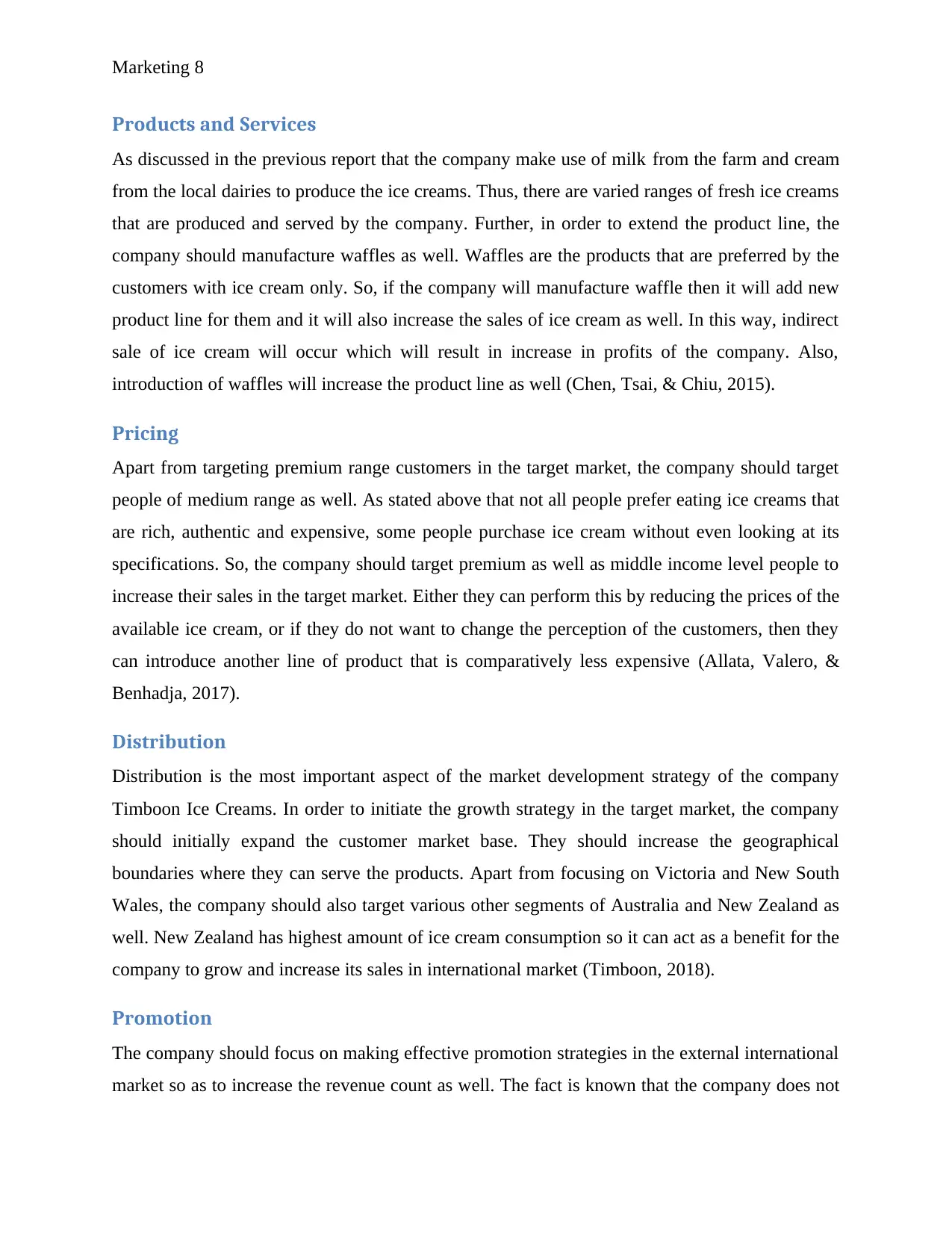
Marketing 8
Products and Services
As discussed in the previous report that the company make use of milk from the farm and cream
from the local dairies to produce the ice creams. Thus, there are varied ranges of fresh ice creams
that are produced and served by the company. Further, in order to extend the product line, the
company should manufacture waffles as well. Waffles are the products that are preferred by the
customers with ice cream only. So, if the company will manufacture waffle then it will add new
product line for them and it will also increase the sales of ice cream as well. In this way, indirect
sale of ice cream will occur which will result in increase in profits of the company. Also,
introduction of waffles will increase the product line as well (Chen, Tsai, & Chiu, 2015).
Pricing
Apart from targeting premium range customers in the target market, the company should target
people of medium range as well. As stated above that not all people prefer eating ice creams that
are rich, authentic and expensive, some people purchase ice cream without even looking at its
specifications. So, the company should target premium as well as middle income level people to
increase their sales in the target market. Either they can perform this by reducing the prices of the
available ice cream, or if they do not want to change the perception of the customers, then they
can introduce another line of product that is comparatively less expensive (Allata, Valero, &
Benhadja, 2017).
Distribution
Distribution is the most important aspect of the market development strategy of the company
Timboon Ice Creams. In order to initiate the growth strategy in the target market, the company
should initially expand the customer market base. They should increase the geographical
boundaries where they can serve the products. Apart from focusing on Victoria and New South
Wales, the company should also target various other segments of Australia and New Zealand as
well. New Zealand has highest amount of ice cream consumption so it can act as a benefit for the
company to grow and increase its sales in international market (Timboon, 2018).
Promotion
The company should focus on making effective promotion strategies in the external international
market so as to increase the revenue count as well. The fact is known that the company does not
Products and Services
As discussed in the previous report that the company make use of milk from the farm and cream
from the local dairies to produce the ice creams. Thus, there are varied ranges of fresh ice creams
that are produced and served by the company. Further, in order to extend the product line, the
company should manufacture waffles as well. Waffles are the products that are preferred by the
customers with ice cream only. So, if the company will manufacture waffle then it will add new
product line for them and it will also increase the sales of ice cream as well. In this way, indirect
sale of ice cream will occur which will result in increase in profits of the company. Also,
introduction of waffles will increase the product line as well (Chen, Tsai, & Chiu, 2015).
Pricing
Apart from targeting premium range customers in the target market, the company should target
people of medium range as well. As stated above that not all people prefer eating ice creams that
are rich, authentic and expensive, some people purchase ice cream without even looking at its
specifications. So, the company should target premium as well as middle income level people to
increase their sales in the target market. Either they can perform this by reducing the prices of the
available ice cream, or if they do not want to change the perception of the customers, then they
can introduce another line of product that is comparatively less expensive (Allata, Valero, &
Benhadja, 2017).
Distribution
Distribution is the most important aspect of the market development strategy of the company
Timboon Ice Creams. In order to initiate the growth strategy in the target market, the company
should initially expand the customer market base. They should increase the geographical
boundaries where they can serve the products. Apart from focusing on Victoria and New South
Wales, the company should also target various other segments of Australia and New Zealand as
well. New Zealand has highest amount of ice cream consumption so it can act as a benefit for the
company to grow and increase its sales in international market (Timboon, 2018).
Promotion
The company should focus on making effective promotion strategies in the external international
market so as to increase the revenue count as well. The fact is known that the company does not
⊘ This is a preview!⊘
Do you want full access?
Subscribe today to unlock all pages.

Trusted by 1+ million students worldwide
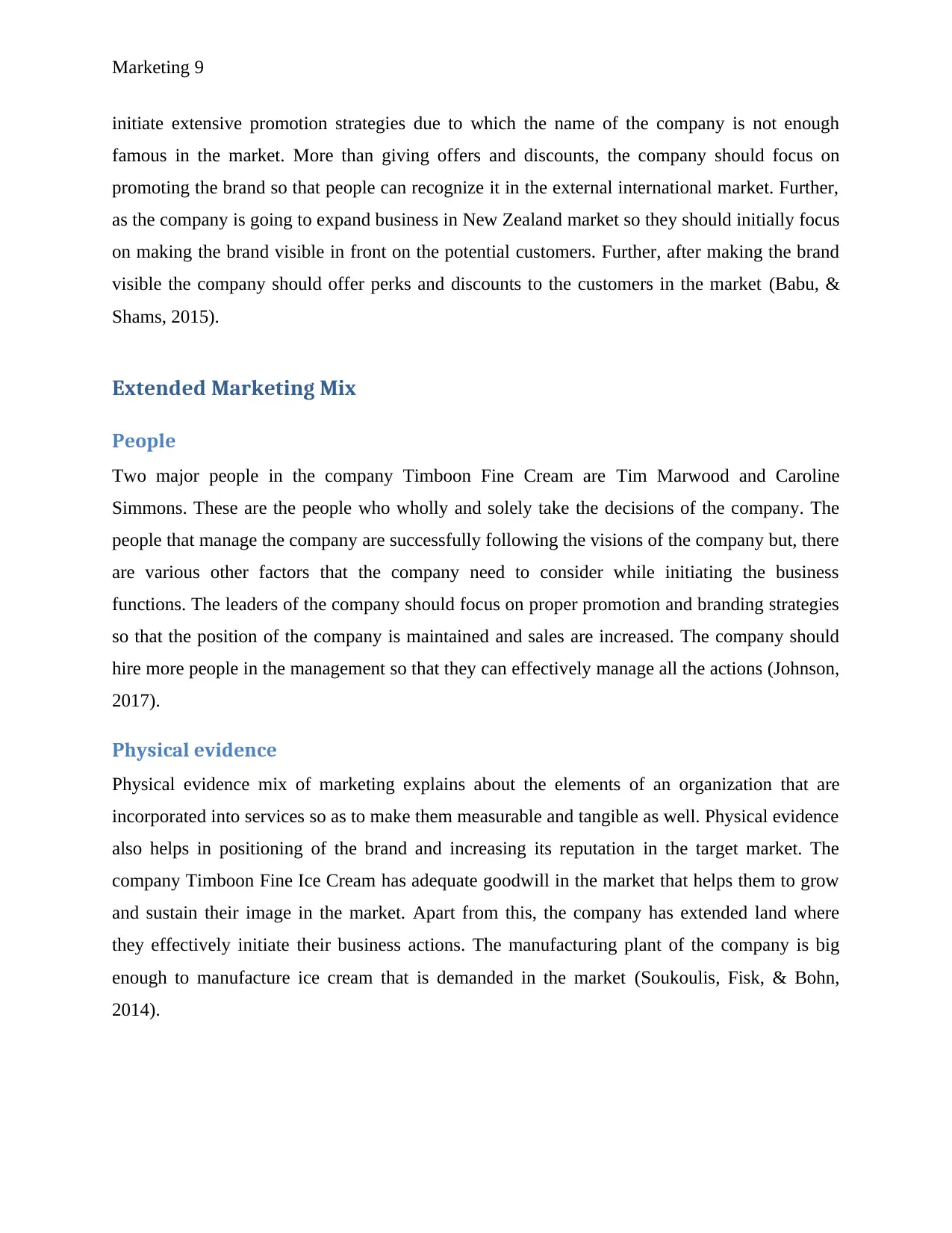
Marketing 9
initiate extensive promotion strategies due to which the name of the company is not enough
famous in the market. More than giving offers and discounts, the company should focus on
promoting the brand so that people can recognize it in the external international market. Further,
as the company is going to expand business in New Zealand market so they should initially focus
on making the brand visible in front on the potential customers. Further, after making the brand
visible the company should offer perks and discounts to the customers in the market (Babu, &
Shams, 2015).
Extended Marketing Mix
People
Two major people in the company Timboon Fine Cream are Tim Marwood and Caroline
Simmons. These are the people who wholly and solely take the decisions of the company. The
people that manage the company are successfully following the visions of the company but, there
are various other factors that the company need to consider while initiating the business
functions. The leaders of the company should focus on proper promotion and branding strategies
so that the position of the company is maintained and sales are increased. The company should
hire more people in the management so that they can effectively manage all the actions (Johnson,
2017).
Physical evidence
Physical evidence mix of marketing explains about the elements of an organization that are
incorporated into services so as to make them measurable and tangible as well. Physical evidence
also helps in positioning of the brand and increasing its reputation in the target market. The
company Timboon Fine Ice Cream has adequate goodwill in the market that helps them to grow
and sustain their image in the market. Apart from this, the company has extended land where
they effectively initiate their business actions. The manufacturing plant of the company is big
enough to manufacture ice cream that is demanded in the market (Soukoulis, Fisk, & Bohn,
2014).
initiate extensive promotion strategies due to which the name of the company is not enough
famous in the market. More than giving offers and discounts, the company should focus on
promoting the brand so that people can recognize it in the external international market. Further,
as the company is going to expand business in New Zealand market so they should initially focus
on making the brand visible in front on the potential customers. Further, after making the brand
visible the company should offer perks and discounts to the customers in the market (Babu, &
Shams, 2015).
Extended Marketing Mix
People
Two major people in the company Timboon Fine Cream are Tim Marwood and Caroline
Simmons. These are the people who wholly and solely take the decisions of the company. The
people that manage the company are successfully following the visions of the company but, there
are various other factors that the company need to consider while initiating the business
functions. The leaders of the company should focus on proper promotion and branding strategies
so that the position of the company is maintained and sales are increased. The company should
hire more people in the management so that they can effectively manage all the actions (Johnson,
2017).
Physical evidence
Physical evidence mix of marketing explains about the elements of an organization that are
incorporated into services so as to make them measurable and tangible as well. Physical evidence
also helps in positioning of the brand and increasing its reputation in the target market. The
company Timboon Fine Ice Cream has adequate goodwill in the market that helps them to grow
and sustain their image in the market. Apart from this, the company has extended land where
they effectively initiate their business actions. The manufacturing plant of the company is big
enough to manufacture ice cream that is demanded in the market (Soukoulis, Fisk, & Bohn,
2014).
Paraphrase This Document
Need a fresh take? Get an instant paraphrase of this document with our AI Paraphraser
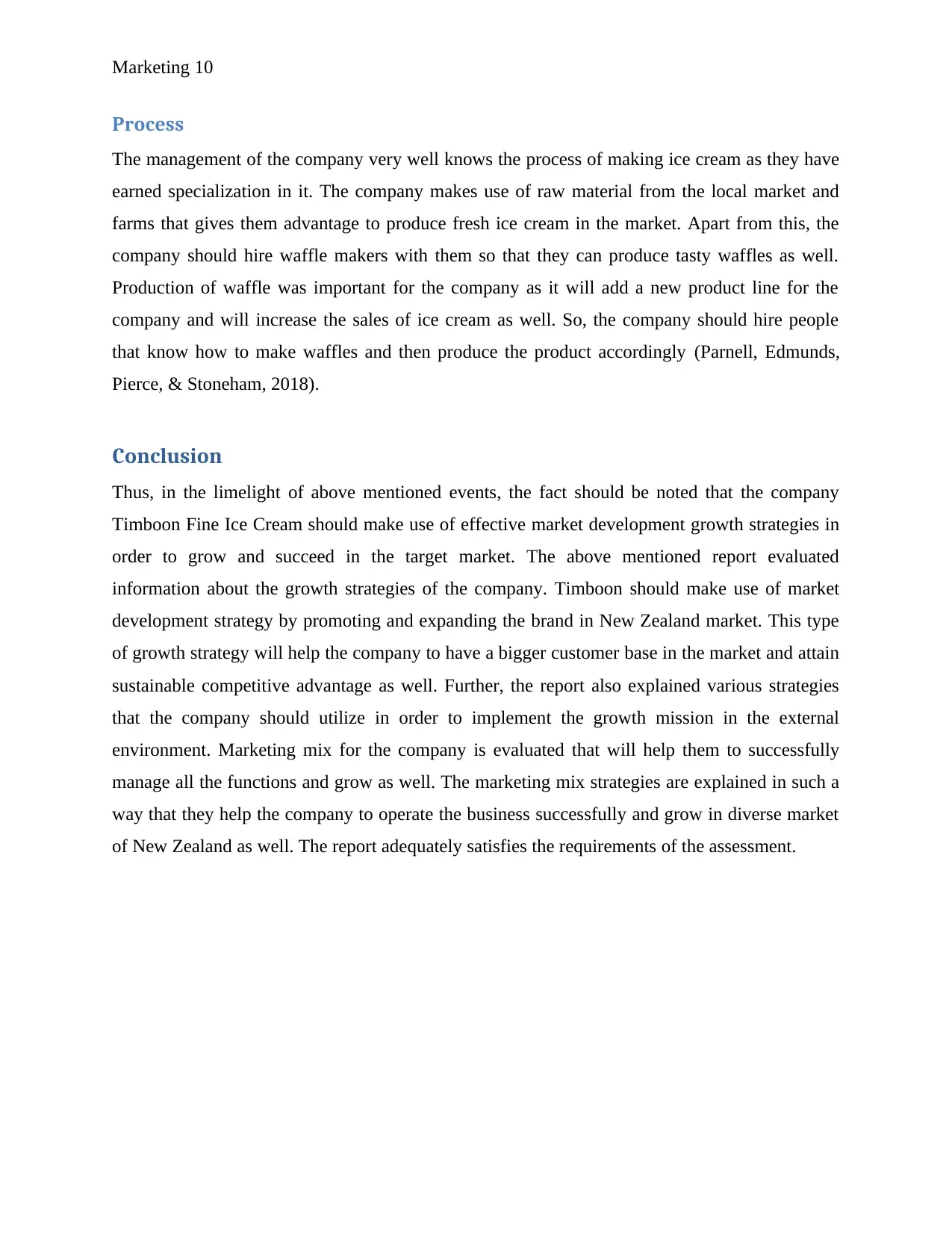
Marketing 10
Process
The management of the company very well knows the process of making ice cream as they have
earned specialization in it. The company makes use of raw material from the local market and
farms that gives them advantage to produce fresh ice cream in the market. Apart from this, the
company should hire waffle makers with them so that they can produce tasty waffles as well.
Production of waffle was important for the company as it will add a new product line for the
company and will increase the sales of ice cream as well. So, the company should hire people
that know how to make waffles and then produce the product accordingly (Parnell, Edmunds,
Pierce, & Stoneham, 2018).
Conclusion
Thus, in the limelight of above mentioned events, the fact should be noted that the company
Timboon Fine Ice Cream should make use of effective market development growth strategies in
order to grow and succeed in the target market. The above mentioned report evaluated
information about the growth strategies of the company. Timboon should make use of market
development strategy by promoting and expanding the brand in New Zealand market. This type
of growth strategy will help the company to have a bigger customer base in the market and attain
sustainable competitive advantage as well. Further, the report also explained various strategies
that the company should utilize in order to implement the growth mission in the external
environment. Marketing mix for the company is evaluated that will help them to successfully
manage all the functions and grow as well. The marketing mix strategies are explained in such a
way that they help the company to operate the business successfully and grow in diverse market
of New Zealand as well. The report adequately satisfies the requirements of the assessment.
Process
The management of the company very well knows the process of making ice cream as they have
earned specialization in it. The company makes use of raw material from the local market and
farms that gives them advantage to produce fresh ice cream in the market. Apart from this, the
company should hire waffle makers with them so that they can produce tasty waffles as well.
Production of waffle was important for the company as it will add a new product line for the
company and will increase the sales of ice cream as well. So, the company should hire people
that know how to make waffles and then produce the product accordingly (Parnell, Edmunds,
Pierce, & Stoneham, 2018).
Conclusion
Thus, in the limelight of above mentioned events, the fact should be noted that the company
Timboon Fine Ice Cream should make use of effective market development growth strategies in
order to grow and succeed in the target market. The above mentioned report evaluated
information about the growth strategies of the company. Timboon should make use of market
development strategy by promoting and expanding the brand in New Zealand market. This type
of growth strategy will help the company to have a bigger customer base in the market and attain
sustainable competitive advantage as well. Further, the report also explained various strategies
that the company should utilize in order to implement the growth mission in the external
environment. Marketing mix for the company is evaluated that will help them to successfully
manage all the functions and grow as well. The marketing mix strategies are explained in such a
way that they help the company to operate the business successfully and grow in diverse market
of New Zealand as well. The report adequately satisfies the requirements of the assessment.
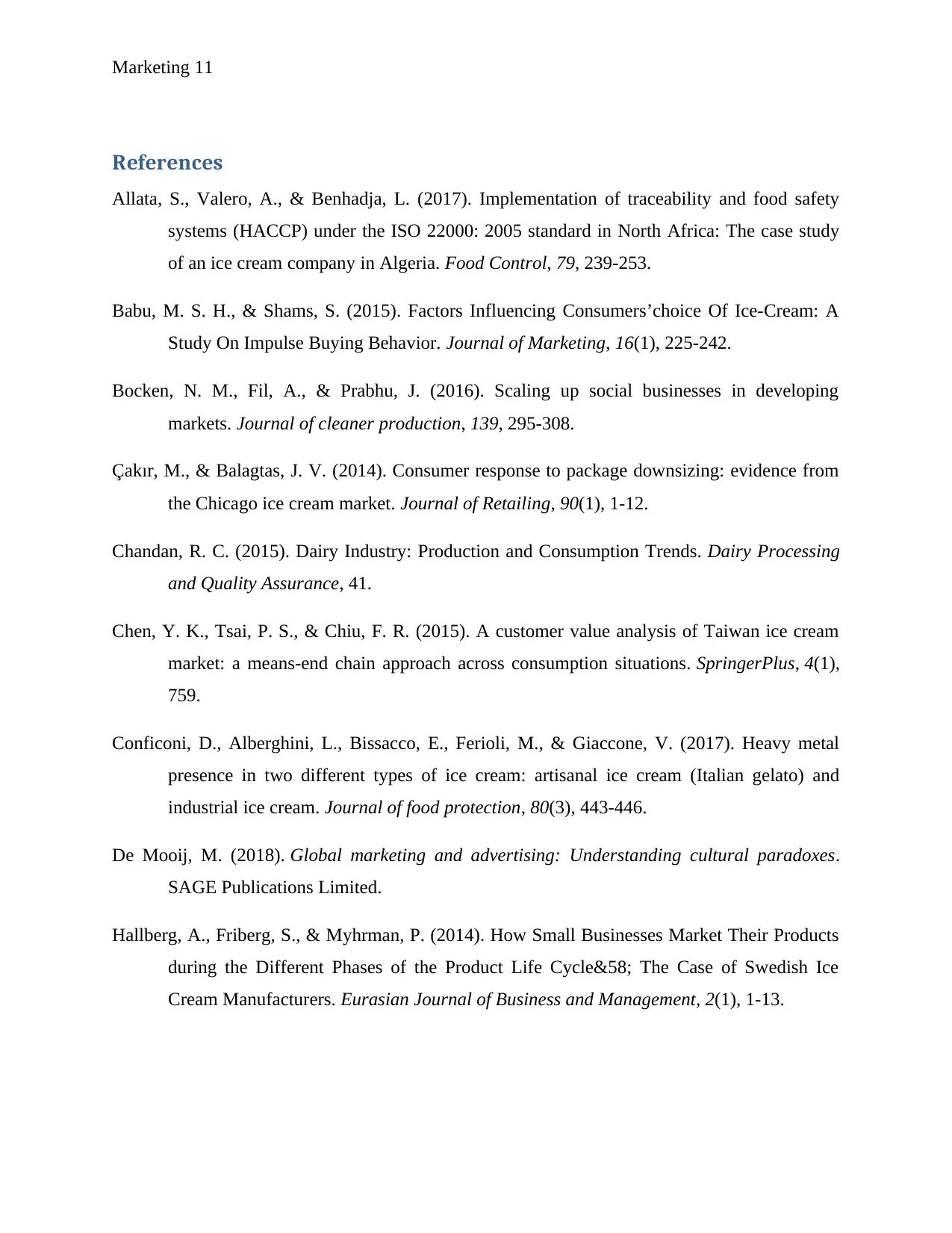
Marketing 11
References
Allata, S., Valero, A., & Benhadja, L. (2017). Implementation of traceability and food safety
systems (HACCP) under the ISO 22000: 2005 standard in North Africa: The case study
of an ice cream company in Algeria. Food Control, 79, 239-253.
Babu, M. S. H., & Shams, S. (2015). Factors Influencing Consumers’choice Of Ice-Cream: A
Study On Impulse Buying Behavior. Journal of Marketing, 16(1), 225-242.
Bocken, N. M., Fil, A., & Prabhu, J. (2016). Scaling up social businesses in developing
markets. Journal of cleaner production, 139, 295-308.
Çakır, M., & Balagtas, J. V. (2014). Consumer response to package downsizing: evidence from
the Chicago ice cream market. Journal of Retailing, 90(1), 1-12.
Chandan, R. C. (2015). Dairy Industry: Production and Consumption Trends. Dairy Processing
and Quality Assurance, 41.
Chen, Y. K., Tsai, P. S., & Chiu, F. R. (2015). A customer value analysis of Taiwan ice cream
market: a means-end chain approach across consumption situations. SpringerPlus, 4(1),
759.
Conficoni, D., Alberghini, L., Bissacco, E., Ferioli, M., & Giaccone, V. (2017). Heavy metal
presence in two different types of ice cream: artisanal ice cream (Italian gelato) and
industrial ice cream. Journal of food protection, 80(3), 443-446.
De Mooij, M. (2018). Global marketing and advertising: Understanding cultural paradoxes.
SAGE Publications Limited.
Hallberg, A., Friberg, S., & Myhrman, P. (2014). How Small Businesses Market Their Products
during the Different Phases of the Product Life Cycle&58; The Case of Swedish Ice
Cream Manufacturers. Eurasian Journal of Business and Management, 2(1), 1-13.
References
Allata, S., Valero, A., & Benhadja, L. (2017). Implementation of traceability and food safety
systems (HACCP) under the ISO 22000: 2005 standard in North Africa: The case study
of an ice cream company in Algeria. Food Control, 79, 239-253.
Babu, M. S. H., & Shams, S. (2015). Factors Influencing Consumers’choice Of Ice-Cream: A
Study On Impulse Buying Behavior. Journal of Marketing, 16(1), 225-242.
Bocken, N. M., Fil, A., & Prabhu, J. (2016). Scaling up social businesses in developing
markets. Journal of cleaner production, 139, 295-308.
Çakır, M., & Balagtas, J. V. (2014). Consumer response to package downsizing: evidence from
the Chicago ice cream market. Journal of Retailing, 90(1), 1-12.
Chandan, R. C. (2015). Dairy Industry: Production and Consumption Trends. Dairy Processing
and Quality Assurance, 41.
Chen, Y. K., Tsai, P. S., & Chiu, F. R. (2015). A customer value analysis of Taiwan ice cream
market: a means-end chain approach across consumption situations. SpringerPlus, 4(1),
759.
Conficoni, D., Alberghini, L., Bissacco, E., Ferioli, M., & Giaccone, V. (2017). Heavy metal
presence in two different types of ice cream: artisanal ice cream (Italian gelato) and
industrial ice cream. Journal of food protection, 80(3), 443-446.
De Mooij, M. (2018). Global marketing and advertising: Understanding cultural paradoxes.
SAGE Publications Limited.
Hallberg, A., Friberg, S., & Myhrman, P. (2014). How Small Businesses Market Their Products
during the Different Phases of the Product Life Cycle&58; The Case of Swedish Ice
Cream Manufacturers. Eurasian Journal of Business and Management, 2(1), 1-13.
⊘ This is a preview!⊘
Do you want full access?
Subscribe today to unlock all pages.

Trusted by 1+ million students worldwide
1 out of 17
Related Documents
Your All-in-One AI-Powered Toolkit for Academic Success.
+13062052269
info@desklib.com
Available 24*7 on WhatsApp / Email
![[object Object]](/_next/static/media/star-bottom.7253800d.svg)
Unlock your academic potential
Copyright © 2020–2025 A2Z Services. All Rights Reserved. Developed and managed by ZUCOL.





